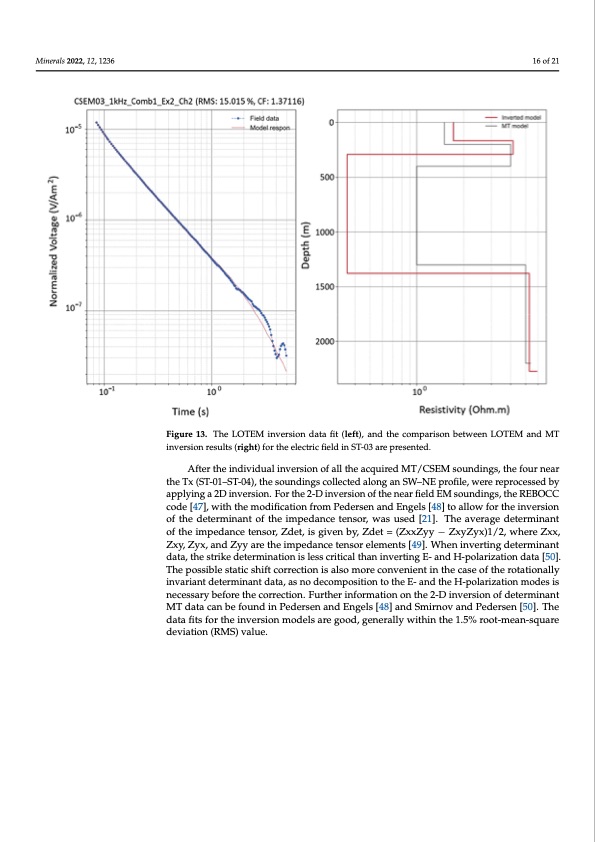
PDF Publication Title:
Text from PDF Page: 016
ure 13, the left diagram. A discrepancy was only found in the late times, after 2.5 sec. For Minerals 2022, 12, 1236 ity layer, with a resistivity of about 0.3 Ohm.m, was detected at a depth of 300–350 m below the ground surface with a thickness of almost 1 km. the inversion of the CSEM data, the final inverted resistivity model from the processing of the MT data at the same station was used as an initial model (Figure 13, right model with the black line). The final inverted model for ST-03 from the processing of the CSEM data is not differentiated from the initial model (form MT data) used. A very low resistiv- 16 of 21 Figure 13. The LOTEM inversion data fit (left), and the comparison between LOTEM and MT Figure 13. The LOTEM inversion data fit (left), and the comparison between LOTEM and MT in- inversion results (right) for the electric field in ST-03 are presented. version results (right) for the electric field in ST-03 are presented. After the individual inversion of all the acquired MT/CSEM soundings, the four near the Tx (ST-01–ST-04), the soundings collected along an SW–NE profile, were reprocessed by applying a 2D inversion. For the 2-D inversion of the near field EM soundings, the REBOCC code [47], with the modification from Pedersen and Engels [48] to allow for the inversion of the determinant of the impedance tensor, was used [21]. The average determinant of the impedance tensor, Zdet, is given by, Zdet = (ZxxZyy − ZxyZyx)1/2, where Zxx, Zxy, Zyx, and Zyy are the impedance tensor elements [49]. When inverting determinant data, the strike determination is less critical than inverting E- and H-polarization data [50]. The possible static shift correction is also more convenient in the case of the rotationally invariant determinant data, as no decomposition to the E- and the H-polarization modes is necessary before the correction. Further information on the 2-D inversion of determinant MT data can be found in Pedersen and Engels [48] and Smirnov and Pedersen [50]. The data fits for the inversion models are good, generally within the 1.5% root-mean-square deviation (RMS) value.PDF Image | First High-Power CSEM

PDF Search Title:
First High-Power CSEMOriginal File Name Searched:
minerals-12-01236-v2.pdfDIY PDF Search: Google It | Yahoo | Bing
Product and Development Focus for Infinity Turbine
ORC Waste Heat Turbine and ORC System Build Plans: All turbine plans are $10,000 each. This allows you to build a system and then consider licensing for production after you have completed and tested a unit.Redox Flow Battery Technology: With the advent of the new USA tax credits for producing and selling batteries ($35/kW) we are focussing on a simple flow battery using shipping containers as the modular electrolyte storage units with tax credits up to $140,000 per system. Our main focus is on the salt battery. This battery can be used for both thermal and electrical storage applications. We call it the Cogeneration Battery or Cogen Battery. One project is converting salt (brine) based water conditioners to simultaneously produce power. In addition, there are many opportunities to extract Lithium from brine (salt lakes, groundwater, and producer water).Salt water or brine are huge sources for lithium. Most of the worlds lithium is acquired from a brine source. It's even in seawater in a low concentration. Brine is also a byproduct of huge powerplants, which can now use that as an electrolyte and a huge flow battery (which allows storage at the source).We welcome any business and equipment inquiries, as well as licensing our turbines for manufacturing.| CONTACT TEL: 608-238-6001 Email: greg@infinityturbine.com | RSS | AMP |